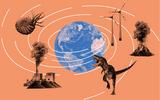MEK – K3 T1 I1 – Looking into the past to glimpse the future
Around 250 million years ago, at the end of the Permian period, a catastrophe occurred: almost all life disappeared from the Earth. This was due, not to a meteorite strike, but to massive volcanic eruptions.
These eruptions released greenhouse gases and ignited coal deposits. Carbon dioxide CO2 concentrations in the atmosphere increased dramatically, and global temperatures rose sharply.
Fires, droughts, acidic oceans and rapid species extinction – the symptoms of global warming caused by CO2 emissions can also be seen today.
Smoking volcanoes or smokestacks – for the atmosphere, it makes no difference where the climate-warming gases come from.
In the Permian period, the swamp forests of the Carboniferous had disappeared. The continents merged to form a single landmass and the climate became drier – an opportunity for reptiles to flourish and develop into diverse forms.
But then all hell broke loose: in Siberia, eruptions from huge fissures in the Earth’s crust covered the land with lava flows – enough to fill what is now the Mediterranean. Vast amounts of greenhouse gases and pollutants such as arsenic created a highly toxic atmosphere.
As a result of the carbon dioxide CO2 emissions, the oceans became so acidic that 95% of marine life died out – molluscs or corals, for example, were no longer able to form shells or skeletons from calcium carbonate.
Scientists have been able to demonstrate the increase in atmospheric carbon dioxide CO2 levels which occurred at that time. They did so by analysing fossil calcareous shells of brachiopods (known as lamp shells), which are similar in appearance to molluscs.
Chemical analyses of the shells indicated a massive rise in CO2 concentrations. The water became increasingly acidic, and air temperatures ever warmer. Acid rain washed nutrients into the oceans, promoting algal blooms that consumed all the oxygen. In addition, the acidic seawater acted as a decalcifier, dissolving the organisms’ chalky shells.
Such effects are also seen with man-made CO2 emissions. But – in contrast to natural disasters – we can do something about this.
→ Objects in the wall display case
Today, vast areas of Siberia are still covered by basalt layers several kilometres thick: this is the prehistoric lava which flowed out of fissures in the Earth’s crust and solidified during the Permian period.
While the Earth has repeatedly experienced lava eruptions, a volcanic natural disaster of this magnitude has not been seen for 250 million years.
Bearing witness to the drama: detailed information on the climate catastrophe of that time can be found in brachiopods, which are similar in appearance to molluscs.
Stored in their shells are chemical fingerprints which indicate carbon dioxide CO2 levels in the atmosphere year by year – thus documenting how they continuously rose.
Unsuspected relatives amidst the lava inferno: Dimetrodon, a carnivorous creature almost two metres in length, looks like a reptile. Or could it be a dinosaur? In fact, it’s neither!
As our ancestor, it already has some features in common with later mammals. This can be seen for example in the structure of its teeth and skull.
For millions of years, these landscapes were populated by early saurians adapted to hot and dry conditions – long before the first dinosaurs appeared.
Many of these agile land-dwellers were already able – unlike amphibians – to lay their eggs away from water. Only a few of these ancestors of later reptiles survived the catastrophe.
→ Object in the floor display case
- A: Mollusc-like brachiopod fossils, useful climate indicators, in wall showcase
- B: Reptile-like amphibian, Discosauriscus, up to 0.4 m long, in floor showcase
- C: Amphibian, Micromelerpeton, 0.2 m long, in floor showcase
- D: Fish suffocated by algal blooms, 0.25 m, in wall showcase
- E: Early relative of mammals, Inostrancevia, a carnivore, 4.5 m long
- F: Dimetrodon, an ancestor of modern mammals – including humans – 3.2 m long
- G: Early relative of mammals, Moschops, a herbivore, 3.5 m long
- H: Reptile-like amphibian, Orobates, 0.9 m long, in floor showcase
- J: Early relative of mammals, Lystrosaurus, survived the Great Dying , 2 m long
- K: Reptile, Mesosaurus, adapted to an aquatic lifestyle, 1 m long
Like all inhabitants of the Earth, we humans are inextricably bound up with the history of our home, this planet.
We have evolved, over an inconceivably long period, from a series of astonishing ancestors – in most cases, the relationship is not immediately obvious. Shown here are just a few important stages in this process.
Discover our astonishing relatives!
- Human
-
Homo sapiens
170 cm
ab 0.3 Mio. Jahre
Holozän
- Early monkey
-
Aegyptopithecus
60 cm
38-29 Mio. Jahre
spätes Eozän – frühes Oligozän
- Early primate
-
Purgatorius
20 cm
65 – 57 Mio. Jahre
Paleozän
- Early mammal with placenta
-
Eomaia
15 cm
130 – 125 Mio. Jahre
frühe Kreide
- Early mammal
-
Morganucodon
11 cm
220 – 170 Mio. Jahre
späte Trias – mittlerer Jura
- Mammal-like reptile
-
Dimetrodon
350 cm
300 – 272 Mio. Jahre
frühes Perm
- Mammal-like reptile
-
Haptodus
150 cm
310 – 285 Mio. Jahre
spätes Karbon – frühes Perm
- First animal with “spine”
-
Myllokunminigia
2.8 cm
525 – 520 Mio. Jahre
frühes Kambrium
- Early single-celled organism
-
0.0001 – 0.00001 cm
Ab 3'600 Mio. Jahre
frühes Präkambrium
